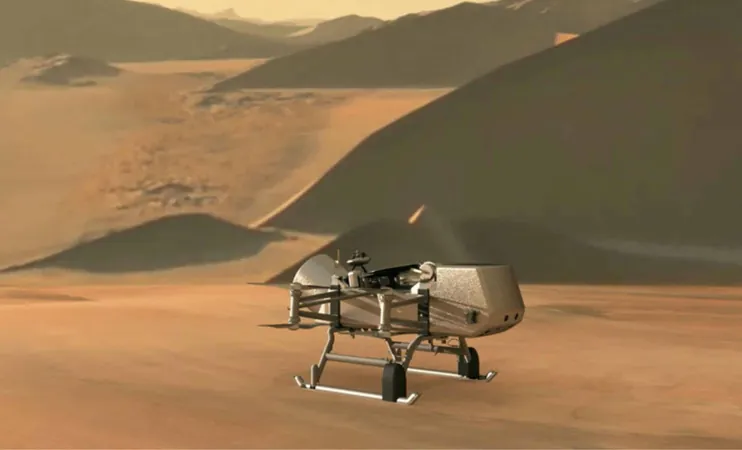
NASA’s NF-5 Mission: A Bold New Era for Exploring the Solar System Awaits!
2025-03-21
Author: Wai
NASA’s NF-5 Mission: A Bold New Era for Exploring the Solar System Awaits!
NASA is gearing up for a groundbreaking venture with its fifth New Frontiers mission, dubbed NF-5, set to embark on a quest to unveil new scientific insights across our solar system. The official announcement is anticipated by 2026, and excitement is brewing within the space research community about the potential discoveries that lie ahead.
The New Frontiers Program: Bridging Ambition and Inquiry
The New Frontiers program serves as a pivotal platform for ambitious exploration, positioned strategically between smaller Discovery-class missions and larger flagship projects. Designed to address significant scientific inquiries, these mid-scale missions are driven by the most critical objectives highlighted in NASA’s Decadal Survey—a consensus from planetary scientists on where resources should be directed.
This latest NF-5 mission will reflect a shift in planning that embraces cutting-edge technologies and urgent scientific priorities. According to Dr. Lori Glaze, director of NASA’s Planetary Science Division, these advancements will enable the agency to explore mission types and targets previously deemed impractical. Moreover, the overlapping timelines of NF-5 and the forthcoming NF-6 cycle will allow research teams more flexibility in crafting comprehensive proposals.
Focusing on the Enigmatic Outer Solar System
A key target for NF-5 is the outer solar system, featuring some of the most mysterious and geologically dynamic entities in our cosmic neighborhood. One of the most compelling mission concepts is the Io Observer, designed to investigate Jupiter's volcanic moon, Io, known for its extreme geophysical phenomena. This project aims to delve into longstanding questions surrounding tidal heating and surface renewal processes, addressing pivotal inquiries identified by the National Academies of Sciences, Engineering, and Medicine.
Additionally, interest in Enceladus, Saturn's icy moon, remains prominent as it continuously releases water vapor plumes—evidence of a subsurface ocean that could harbor life. Proposals to sample or image these plumes carry significant astrobiological implications, delivering insights into the moon’s chemical makeup and its potential to host microbial ecosystems.
Furthermore, NF-5 is exploring missions targeting the elusive Centaur bodies and comets, with the goal of enabling surface landings or sample-return operations. These icy remnants hold secrets about the solar system's formative years, and studying them could illuminate our understanding of planetary development.
The Saturn Probe: A Gateway to the Gas Giants
Another exciting prospect within the NF-5 framework includes dedicated missions aimed at the gas giants, particularly Saturn. A Saturn Probe could deliver unprecedented data concerning the chemical composition, temperature gradients, and atmospheric dynamics of the planet. Given the absence of direct atmospheric measurements since the end of the Cassini mission in 2017, this endeavor is critical for enhancing our understanding of gas giants.
An Emphasis on Lunar Concentration
Notably, NF-5 is also placing a strong emphasis on lunar science. The proposal for a Lunar Geophysical Network stands out, which aims to deploy a series of instruments on the Moon’s surface to gather seismic, thermal, and magnetic data. This comprehensive data collection would significantly improve our comprehension of the Moon’s internal structure, paving the way for both scientific exploration and future crewed missions under NASA’s Artemis program.
The synergy between lunar science and human exploration encapsulates a central goal of NASA’s integrated exploration strategy, enabling us to discover resource-rich regions while investigating our nearest celestial neighbor.
What Makes NF-5 Unique?
Distinct from prior New Frontiers missions, NF-5 is characterized by its pioneering use of innovative instrumentation, advanced spacecraft designs, and new propulsion systems. These developments promise longer missions with precise targeting capabilities, enabling the pursuit of multiple objectives simultaneously.
Moreover, the anticipated diversity of mission targets—from inner solar system bodies like the Moon to distant icy moons and gas giants—reflects NASA’s commitment to capturing the rich complexity of planetary formation and evolution across the solar system.
As anticipation builds for NF-5, scientists and enthusiasts alike are left wondering: what extraordinary discoveries await us within the depths of space? Stay tuned as this mission promises to reshape our understanding of our cosmic neighborhood!

 Brasil (PT)
Brasil (PT)
 Canada (EN)
Canada (EN)
 Chile (ES)
Chile (ES)
 Česko (CS)
Česko (CS)
 대한민국 (KO)
대한민국 (KO)
 España (ES)
España (ES)
 France (FR)
France (FR)
 Hong Kong (EN)
Hong Kong (EN)
 Italia (IT)
Italia (IT)
 日本 (JA)
日本 (JA)
 Magyarország (HU)
Magyarország (HU)
 Norge (NO)
Norge (NO)
 Polska (PL)
Polska (PL)
 Schweiz (DE)
Schweiz (DE)
 Singapore (EN)
Singapore (EN)
 Sverige (SV)
Sverige (SV)
 Suomi (FI)
Suomi (FI)
 Türkiye (TR)
Türkiye (TR)
 الإمارات العربية المتحدة (AR)
الإمارات العربية المتحدة (AR)